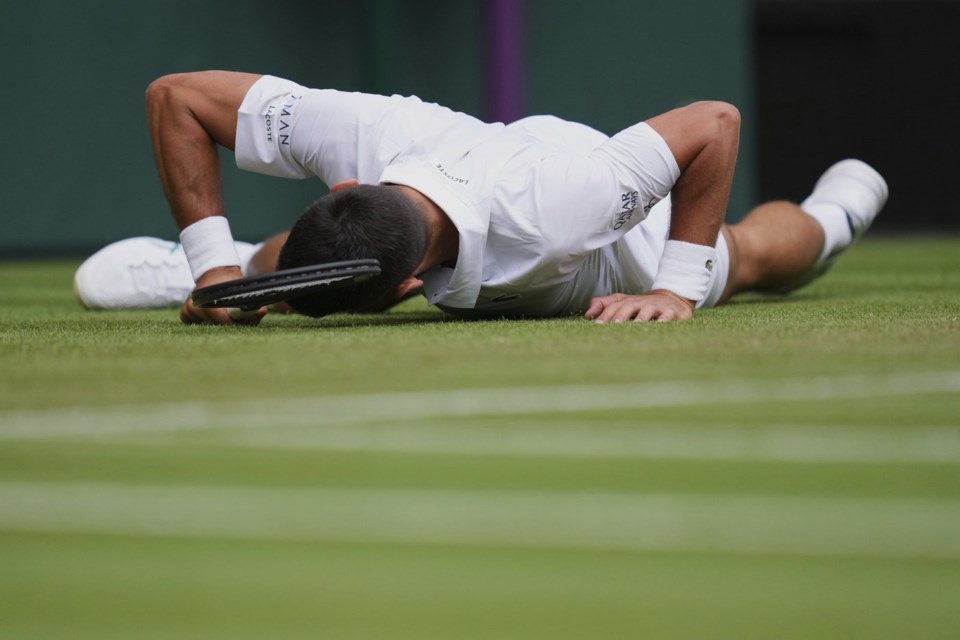LONDON (AP) — Successful as Novak Djokovic has been on the grass courts of Wimbledon — he's won 100 matches and seven of his 24 Grand Slam trophies there — it's not as if he grew up plying his talents on the surface.
Indeed, he never competed or even practiced on it at all until 2005, when he entered the qualifying event held at the nearby Roehampton facility and won three matches there to earn the right to make his debut at the All England Club at age 18.
“That was actually the first year I stepped out on the grass,” said Djokovic, who will play 11th-seeded Alex de Minaur on Monday for a quarterfinal berth at the Grand Slam tournament. “I must say that it felt very natural for me to adapt to it, even though I grew up on clay.”
There will be a 9th different women's champion in the last 9 Wimbledons
That's a common refrain among today's pros, and the lack of familiarity with, and comfort on, grass could be one of the reasons for all of the upsets in the early going at Wimbledon. The eight total top-10 seeds — four women, four men — who lost in the first round were the most at any major since they began seeding 32 in brackets in 2001.
“Grass,” 2022 champion Elena Rybakina said after her third-round exit Saturday, “is very unpredictable.”
With her departure, and defending champ Barbora Krejcikova's loss to Emma Navarro a few hours later, there is guaranteed to be yet another first-time women's title winner this year at the All England Club. Whoever takes home the trophy on July 12 will be the ninth woman to do so in the event's past nine editions.
Why are the All England Club's grass courts so unpredictable?
Plenty of top players learned to play tennis on hard courts, especially in North America, or clay courts, especially in Europe and Latin America. Grass? Not so much, except for those from England or Australia. It's an acquired taste and skill, and it doesn't help anyone that the portion of the season spent on the turf is so abbreviated.
“Usually when I was on grass,” joked Eva Lys, a 23-year-old German who reached the second round at Wimbledon, “it was when I was tanning.”
There are more than 35 hard-court tournaments listed on the 2025 WTA calendar, 11 held on clay and seven on grass, which is used from June 9 through Wimbledon.
“It’s not just that we only play on grass for about a month,” said Lorenzo Musetti, a semifinalist at the All England Club a year ago and a first-round loser as the No. 7 seed this time. “It’s a surface that requires a lot of adapting. You have to go by feeling.”
The bounces and movement are different on Wimbledon’s grass courts
There isn't much of a chance to get used to the slippery footing, needing to bend one's knees to reach shots that skid more than bounce, or dealing with the inconsistent ways balls move.
“Everything is so different about it,” said Tommy Paul, the 13th-seeded American who bowed out in the second round after coming down awkwardly on his foot during a point.
Growing up in North Carolina, Paul picked up a racket at age 7 and his first surface was green clay. It wasn't until he was 15 or 16 that he first tried hitting on grass, at a junior event at the Philadelphia Cricket Club.
“I was probably diving all over the court when I didn’t need to. I’ve always said it’s the most fun surface to play on,” Paul said. “I like the disorder about it."
His grass debut arrived earlier than for many who reach the sport's top levels. Like Djokovic, most never set foot on on the stuff until they're about 17 or 18 and heading to England (unlike Djokovic, usually for Wimbledon's junior tournament).
Some have one rough encounter that sticks with them.
Naomi Osaka, a former No. 1 and four-time Grand Slam champion on the hard courts of the U.S. Open and Australian Open, slipped and hurt her knee nearly a decade ago on grass and that created fear, she said. She has never been past the third round at Wimbledon.
Iga Swiatek, another former No. 1 and the owner of five major trophies earned elsewhere, did win a junior Wimbledon title, but it's her least-successful Slam as a pro. She will try to equal her run by getting to the quarterfinals with a victory against No. 23 Clara Tauson on Monday.
“This year on grass, I had some moments where I just felt comfortable and I didn’t have to think much,” Swiatek said. “It was just pretty smooth.”
___
AP tennis: https://apnews.com/hub/tennis
Howard Fendrich, The Associated Press



